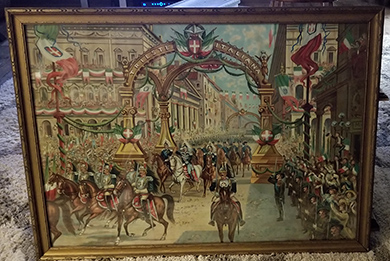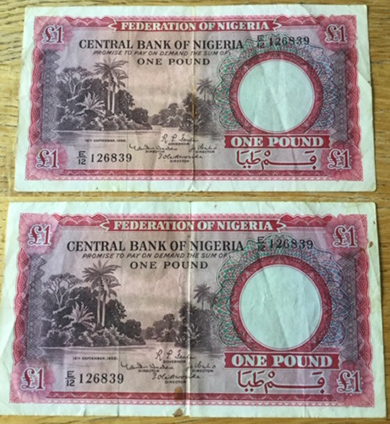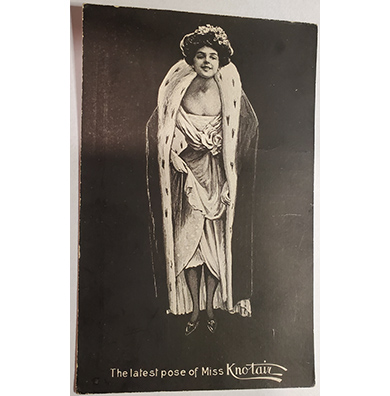 |
|
|||
 |
 |
|||
RINKER ON COLLECTIBLES — Column #1729 Copyright © Harry Rinker, LLC 2020 Questions
and Answers
QUESTION: My wife’s grandfather, a first-generation Sicilian immigrant, owned a large, framed print of a military parade marching up a city street. A cavalry honor guard appears in front of a figure (a high-ranking officer?) riding a white horse followed by several ranks of cavalry. The parade is passing under a triumphal arch that reads “TRIESTE / [central cartouche with Italian flag motif] / ITALIANA.” Does this print have any value or should I send it to Good Will? – BL, Furnace, PA, E-mail Question 
ANSWER: Trieste, located at the head of the Gulf of Trieste, is a city/seaport in northeast Italy. It is situated in a narrow strip of Italian territory lying between the Adriatic Sea and Slovenia. It is the crossroads of Germanic, Latin, and Slavic cultures. When Venice renounced its claim to Trieste after the Peace of Turin in 1381, the citizens of Trieste asked to become part of the Hapsburg Empire. The Venetians occupied Trieste in 1508, only to have the city return to the Hapsburg Empire a year later. By the 18th century, Trieste became an important commercial hub and port for Austria. Emperor Charles VI granted Trieste the status of a free port which it retained until July 1, 1799. During the Napoleonic Wars, the French Army occupied Trieste in 1797, 1805, and 1809. Trieste was annexed to the Illyrian Provinces from 1809 to 1812. The Austrian Empire regained control in 1813. Trieste prospered. In 1882, Guglielmo Oberdan, an activist who favored annexation of Trieste to Italy, attempted to assassinate Emperor Franz Joseph during a visit to Trieste. At the beginning of the 20th century, Trieste was a cosmopolitan city frequented by artists and philosophers such as Sigmund Freud, James Joyce, and Umberto Saba and gained a reputation as the Austrian Riviera. After Italy entered World War I on the side of the Allies, it expected to receive territorial gains under terms of the 1915 Treaty of London. Over 1,000 citizens of Trieste refused to fight under the Austro-Hungarian flag. In November 1918, Trieste was united with Italy. As a result of the Italian-Yugoslav 1920 Treaty of Rappallo, Italy, the formal annexation of the city and Venezia Guilia took place between November 1920 and January 1921. Although there was a majority Italian population in Trieste, much of the region was dominated by people of Slavic origin. The Fascist Black Shirts waged a cleansing campaign forcing Slavs to Italianize. This historical background is necessary to understand the event pictured in your print. The print portrays a parade that occurred on Sunday, March 20, 1921. The following excerpt is from Annie Cohen-Solal’s “Leo and His Circle”: “The city of Trieste with daunting majesty, celebrated the official annexation of Venezia Guilia to the Kingdom of Italy. The Piazza Grande was full to bursting, the crowd huddled in every corner…tricolors waving everywhere…Among those assembled in the piazza, some were in dark uniform, some in white with epaulettes and full decoration, with ostrich-plumed shakos…The generals, admirals, ministers, and other dignitaries, the mayor of Turin, Naples, Venice, Bologna, and Florence, and almost every government official on the peninsula came…everyone except the king.” Two questions remain. First, why did a Sicilian own a print of an historical event that happened so far north? I have no answer to this question. Second, what is the value of the print? As with all antiques and collectibles, it depends on the buyer. An Italian nationalist in Trieste will pay one price. A non-Italian, no matter his or her political or nationalist preference, will pay far less or nothing at all. Your email did not provide the size of the framed print, albeit the image accompanying your email suggests it is rather large. It also is in full color. As a result, the print has display value. On the open market, its value is between $45.00 and $60.00. In a specialized “Italian” marketplace, for example as decoration in an Italian social hall, its value is double. QUESTION: I have two (2) One Pound banknotes issued by the Central Bank of Nigeria. The engraving on the front is a river scene. The back has an image of natives harvesting cocoa pods. The background color of the note is red. The bills are wrinkled and have some staining. They are 100% genuine. I found them in a new package straight from the bank. Do you have any idea what they might be worth? – HS, Netherland, Email Question 
ANSWER: On July 1, 1959, the Central Bank of Nigeria replaced the West African Currency Board as the issuer of Nigerian currency. The old West African Currency Board coins and notes remained valid until July 1, 1962. In 1963, Nigeria became a Republic. In 1965, new banknotes were issued to reflect Nigeria’s new status. Nigeria used the imperial pound until 1973. Your One Pound notes were part of the July 1, 1959, Central Bank of Nigeria currency issue. Five pound, one pound, ten shilling, and five shilling notes were issued. Coins included two shillings, three pence, one penny and one-half penny. The one pound note measured 4 5/16 inches by 3 5/16 inches. The 1959 issued paper currency was withdrawn in 1965. The 1959 issued coins were withdrawn in 1973. From a collecting perspective, your banknotes are in fair to good condition. They show heavy use. The asking price for a mint condition Nigerian 1959 issue one-pound note is between $15.00 and $20.00. Such notes are readily available in the secondary market. An example in fair to good condition is worth between $3.00 and $4.00. The note only has collector value. It can no longer be used as or redeemed for modern currency. QUESTION: I have a 33 1/3 rpm vinyl record in its original dust jacket. The album title is “Voices From the Moon.” It was a Philco premium. What is its value? – SD, Lansdale, PA, Email Question ANSWER: Your 7-inch 33 1/3 rpm record was produced by Eva Tone for Philco-Ford. It contains recordings of the various transmissions from the astronauts who landed on the moon on July 20, 1969 as part of the Apollo 11 mission. The back of the jacket reads: “Better ideas in space and in the home…Philco-Ford Corporation is proud of its role as prime contractor to the National Aeronautics and Space Administration for the design and installation of the control center at NASA’s Manned Spacecraft Center in Houston.” The Philco-Ford giveaway was one of several records of voices associated with the moon landing issued within months of the actual landing. CBS News issued “Man on the Moon,” narrated by Walter Cronkite. A “sale date” check on WorthPoint.com revealed that Philco-Ford “Voices From The Moon” sold between $10.00 and $12.00 in 2019. Several appear for sale each month. QUESTION: I have a postcard that pictures a young, society lady wearing an ermine cape over a low-cut evening gown. She is lifting the bottom of her dress and exposing the lower portion of her legs. The cut line reads: “The latest pose of Miss Knotair.” What is the history behind my postcard? Does it have value? – RK, King of Prussia, Email Question 
ANSWER: The October 16, 1909 issue of “The Saturday Evening Post” contains an advertisement from the Knotair Hosiery Company, 5301 Westminster Avenue, Philadelphia, Pennsylvania. The advertisement is headlined: “We Don’t Care – We Wear.” A Knotair banner across the center of the advertisement reads: “‘The Guaranteed / Best Quality’ / for men and women.” The advertisement proclaims: “For QUALITY, SNAP, and STYLE, KNO-TAIR is the PREMIER of all GUARANTEED HOSE – Sheer, Fine, Gauze-like QUALITY – SEAMLESS, too – and SHAPLEY.” A 1908 Christmas advertisement included a listing for “Women’s Pure Silk Lisle Hosiery made in Black, White, Tan, Ox-Blood, Copenhagen Green, Heliotrope Purple, Pink, Sky Blue, all fashionable colors, size 8 to 10 1/2; packed one size, six pairs to the box (assorted colors if desired; interlaced garter splicing; Price $3.00 the box. Guaranteed to wear SIX MONTHS or MORE.” Knotair advertised heavily in the first two decades of the 20th century. Its distributors included Brummel & Mendelsohn in New York and Joel Bailey Davis Co. in Philadelphia. I was not able to find any information about “Miss Knotair.” My best guess is that your postcard dates between 1908 and 1910. The postcard has a curiosity value of between $3.00 and $5.00. It appeals to Philadelphia collectors, hosiery collectors, fashion collectors, and women who collect stereotype feminist material. Harry L. Rinker welcomes questions from readers about
collectibles, those mass-produced items from the twentieth and twenty-first centuries.
Selected letters will be answered in this column.
Harry cannot provide personal answers.
Photos and other material submitted cannot be
returned.
Send your questions to: Rinker on Collectibles, 5955 Mill
Point Court SE, Kentwood, MI 49512.
You also can e-mail your questions to
harrylrinker@aol.com.
Only e-mails containing a full name and mailing address
will be considered.
|
||||